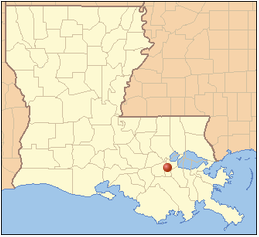| Home | Search | Emissions | Pollutants | About the Database |

Marathon Ashland Petroleum (3165), Garyville
LDEQ Accident Report
| Accident # | 149911 |
| State Police # | 13-03275 |
| Accident Date | 2013-07-24 |
| Report Date | 2013-09-04 |
| Follow-up Date | 2013-10-23 |
| Follow-up: | Yes |
Pollutants Released
| Pollutant | Duration | Point Source | Greenhouse Gas | Criteria Pollutant | Ozone forming chemical | Amount of Release |
| Sulfur Dioxide | 1h | Unit 259 North Ground Flare | NO | YES | NO | 613.0 pounds |
Accident Classified As: Reportable Quantity
Cause of Problem: Process Upset
On July 24, the Unit 222 Debutanizer Accumulator level reached 100%. This condition caused the pressure controller to open sending liquid overhead to the Unit 210 Compressor Suction Drum. The high level in the Compressor Suction Drum caused a shutdown of the Crude Overhead Compressors and a release to the North Ground Flare.
Discharge Preventable - No
The release was due to a pressure control valve opening to the Low Pressure Recovery Header. The pressure control valve allowed liquid into the Unit 210 Compressor Suction Drum causing the Unit 210 Compressor to trip.
Notes/Remedial Actions
Liquid was drained from the Unit 210 Compressor Suction Drum. The unit 210 Crude Overhead Compressor was restarted. To prevent recurrence of a liquid overfill from putting liquid into the Low Pressure Recovery Header (LPRH) and tripping the U210 compressors, it is recommended to: institute a high level override on 222PC0316-02 that will close 222PC0316-02 in the event of a high level in the Debutanizer Accumulator; institute a high level trip on U214 Feed Surge Drum pressure controller, U214 LP Stripper Overhead Receiver, U215 Coker Feed Surge Drum, U215 Feed Surge Drum, U215 Fractionator Overhead Receiver, and U215 Naphtha Splitter Overhead Receiver that will close the vent to the LPRH in the event of a high level in the respective vessel. To prevent recurrence of tripping the compressors due to overwhelming the Suction Drum pumps, it is recommended to: evaluate all sources to the LPRH that do not currently have a control valve, and evaluate all sources to the Eocene header to determine if additional safeguard are required to prevent liquid carryover. Also, it is recommended to determine what the normal operating pressure and low alarm set point should be to insure the Interstage KO Drum Pumps can successfully pump any material that condenses in the KO drum, update the alarm database with information regarding the importance of KO drum pressure on operation of the KO Drum pumps, and evaluate the performance of the U210 Interstage KO Drum Pressure during INC49711 to determine if tuning parameters can be changed or controls modified to allow the pressure set point on the drum to be reached quickly after startup of the U210 compressors. An additional followup on 10/23/13 corrected the initial followup report's emissions data regarding greenhouse gas releases.

Connect With Us: